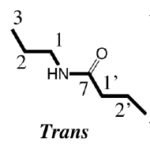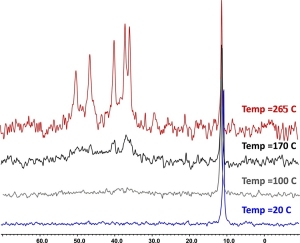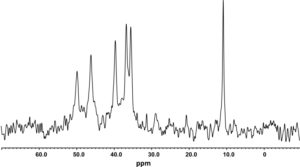Temperature Dependence of the 13C NMR of Nylon 6,6 — Liquids- Z Gradient Probe up to 300°C
NEW – Liquids PFG Z Gradient Probe with Temperatures up to 300°C
 |
Temperature Dependence of the 13C NMR of Nylon 6,6
|
 |
| We tested the probe’s high temperature capability by examining the melting behavior of a Nylon rod in a 5-mm NMR tube of silicon oil – see photo. Note there was a thin film of oil surrounding and covering the nylon rod. The rod is a mixture of cis and trans nylon (Nylon 6,6). The structure of the trans monomer form appears below. The probe was first tuned for 500 MHz, where upon we collected spectra on our 500 MHz NMR spectrometer (basically a hybrid system with a single console driving two magnets (11.7 and 7.05 T). The probe was re-tuned for 7.05 T and spectra were also taken at 300 MHz. The spectra acquired on our 7.05 T magnet are shown in the figures following. The spectra were acquired at 75 MHz for 13C with 1H decoupling. These temperature-dependent data were acquired by Dr. Daniel Arcos and Mr. John Staab. The portions here are an expansion from 70 ppm to -10 ppm. The resonances shown arise from carbons 1, 2, 3, 1’, and 2’. The first point to notice is the room temperature spectrum. The resonance at ~12 ppm is the silicon oil. As the temperature is increased several observations can be made. Note the region between 30 ppm and 55 ppm. Here even at 100 °C one is just beginning to see an ill-defined feature growing in. The feature is more apparent at 170 °C. Only at 265 ∘C do we observe a spectrum which matches closely the spectrum of nylon 6,6 published for the room temperature 13C spectrum of nylon 6,6 dissolved in 80%/20% of 2,2,2-trifluoroethanol in DCCl3. (In the full spectrum, not shown here, there is another resonance near 180 ppm.) The reported melting point of Nylon 6,6 is 264 °C.This probe is rated for 280 °C, and hence we stopped below this point. (We have tested another version of the probe to 300°C.) After reaching this temperature the probe was cooled and then using a fresh sample, we collected more spectra as the probe was run up to 265 ∘C. Upon cooling, the probe was rigorously tested and found to be meeting all of our specifications.A more detailed picture of the probe performance is illustrated in the panel to the right. We believe this if the first 13C spectrum of a nylon melt. | Sample: Nylon 6,6 rod in Silicone Oil
ppm 13C
|
wp ecommerce – e-commerce





